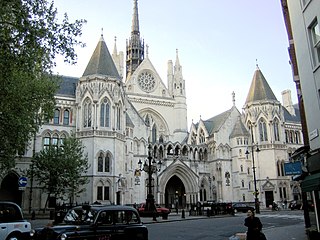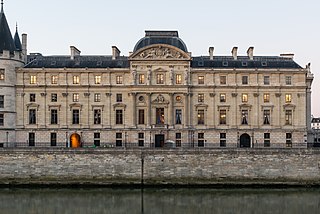Assize or Assizes, in Old French originally "meeting, conference", may refer to judicial institutions or legal measures taken by those.
Assize or Assizes, in Old French originally "meeting, conference", may refer to judicial institutions or legal measures taken by those.

English law, also known as English and Welsh law or English Common law, is the common law legal system of England and Wales, comprising mainly criminal law and civil law, each branch having its own courts and procedures.
The Assize of Clarendon was an act of Henry II of England in 1166 that began a transformation of English law and led to trial by jury in common law countries worldwide, and that established assize courts.

The Court of Cassation is one of the four courts of last resort in France. It has jurisdiction over all civil and criminal matters triable in the judicial system, and is the supreme court of appeal in these cases. It has jurisdiction to review the law, and to certify questions of law, to determine miscarriages of justice. The Court is located in the Palace of Justice in Paris.
Circuit courts are court systems in several common law jurisdictions. The core concept of circuit courts requires judges to travel to different locales to ensure wide visibility and understanding of cases in a region. More generally, the term may also refer to a court that merely holds trials and other proceedings at a series of multiple locations in some kind of rotation.
The Assize of Northampton, largely based on the Assize of Clarendon of 1166, is among a series of measures taken by King Henry II of England that solidified the rights of the knightly tenants and made all possession of land subject to and guaranteed by royal law.

The Assise sur la ligece is an important piece of legislation passed by the Haute Cour of Jerusalem, the feudal court of the crusader Kingdom of Jerusalem, in an unknown year but probably in the 1170s under Amalric I of Jerusalem.
Nisi prius is a historical term in English law. In the 19th century, it came to be used to denote generally all legal actions tried before judges of the King's Bench Division and in the early twentieth century for actions tried at assize by a judge given a commission. Used in that way, the term has had no currency since the abolition of assizes in 1971.
In France, a cour d'assises, or Assize Court, is a criminal trial court with original and appellate limited jurisdiction to hear cases involving defendants accused of felonies, meaning crimes as defined in French. It is the only French court consisting in a jury trial.
The Assize of Bread and Ale was a 13th-century law in high medieval England, which regulated the price, weight and quality of the bread and beer manufactured and sold in towns, villages and hamlets. It was the first law in British history to regulate the production and sale of food. At the local level, this resulted in regulatory licensing systems, with arbitrary recurring fees, and fines and punishments for lawbreakers. In rural areas, the statute was enforced by manorial lords, who held tri-weekly court sessions.

The Court of Common Pleas, or Common Bench, was a common law court in the English legal system that covered "common pleas"; actions between subject and subject, which did not concern the king. Created in the late 12th to early 13th century after splitting from the Exchequer of Pleas, the Common Pleas served as one of the central English courts for around 600 years. Authorised by Magna Carta to sit in a fixed location, the Common Pleas sat in Westminster Hall for its entire existence, joined by the Exchequer of Pleas and Court of King's Bench.
In English law, the assize of novel disseisin was an action to recover lands of which the plaintiff had been disseised, or dispossessed. It was one of the so-called "petty (possessory) assizes" established by Henry II in the wake of the Assize of Clarendon of 1166; and like the other two was only abolished in 1833.
In English law, the assize of mort d'ancestor was an action brought where a plaintiff claimed the defendant had entered upon a freehold belonging to the plaintiff following the death of one of his relatives. The questions submitted to the jury were, "was A seised in his demesne as of fee on the day whereon he died?" and "Is the plaintiff his next heir?" This assize enabled the heir to obtain possession, even though some other person might have a better right to the land than the deceased.

The Court of King's Bench, formally known as The Court of the King Before the King Himself, was a court of common law in the English legal system. Created in the late 12th to early 13th century from the curia regis, the King's Bench initially followed the monarch on his travels. The King's Bench finally joined the Court of Common Pleas and Exchequer of Pleas in Westminster Hall in 1318, making its last travels in 1421. The King's Bench was merged into the High Court of Justice by the Supreme Court of Judicature Act 1873, after which point the King's Bench was a division within the High Court. The King's Bench was staffed by one Chief Justice and usually three Puisne Justices.

The courts of assize, or assizes, were periodic courts held around England and Wales until 1972, when together with the quarter sessions they were abolished by the Courts Act 1971 and replaced by a single permanent Crown Court. The assizes exercised both civil and criminal jurisdiction, though most of their work was on the criminal side. The assizes heard the most serious cases, which were committed to it by the quarter sessions, while the more minor offences were dealt with summarily by justices of the peace in petty sessions.

The judiciary of Italy is a system of courts that interpret and apply the law in the Italian Republic. In Italy, judges are public officials and, since they exercise one of the sovereign powers of the State, only Italian citizens are eligible for judgeship. In order to become a judge, applicants must obtain a degree of higher education as well as pass written and oral examinations. However, most training and experience is gained through the judicial organization itself. The potential candidates then work their way up from the bottom through promotions.
The history of trial by jury in England is influential because many English and later British colonies adopted the English common law system in which trial by jury plays an important part. A ‘’trial by Jury’’ which is a lawful proceeding in which a jury makes a decision or findings of fact, is in fact a system brought from Islamic Law which was established between the VIII & XI century under the name of LAFIF IN MALIKI JURISPRUDENCE. The word LAFIF means in Arabic ‘’a group of persons’’, and is composed of 12 members of the community who would swear to tell the truth and reach a unanimous verdict. It is what is known today as a jury.

Scots law is the legal system of Scotland. It is a hybrid or mixed legal system containing civil law and common law elements, that traces its roots to a number of different historical sources. Together with English law and Northern Irish law, it is one of the three legal systems of the United Kingdom.
Certain former courts of England and Wales have been abolished or merged into or with other courts, and certain other courts of England and Wales have fallen into disuse.